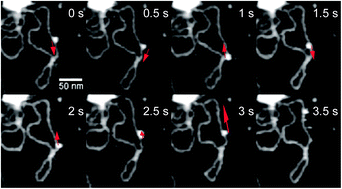Protein–DNA interactions in high speed AFM: single molecule diffusion analysis of human RAD54†
Abstract
High-speed

Maintenance work is planned for Wednesday 1st May 2024 from 9:00am to 11:00am (BST).
During this time, the performance of our website may be affected - searches may run slowly and some pages may be temporarily unavailable. If this happens, please try refreshing your web browser or try waiting two to three minutes before trying again.
We apologise for any inconvenience this might cause and thank you for your patience.
* Corresponding authors
a
Department of Cell Biology and Genetics, Cancer Genomics Center, Erasmus MC, PO Box 2040, 3000 CA Rotterdam, The Netherlands
E-mail:
h.sanchezgonzalez@erasmusmc.nl
Fax: +31 (0)10 704 4743
Tel: +31 (0)10 704 3158
b Laboratory of Plasma Membrane and Nuclear Signaling, Graduate School of Biostudies, Kyoto University, Yoshida-Konoe-cho, Sakyo-ku, Kyoto 606-8501, Japan
c Department of Radiation Oncology, Erasmus MC, PO Box 2040, 3000 CA Rotterdam, The Netherlands
High-speed

 Please wait while we load your content...
Something went wrong. Try again?
Please wait while we load your content...
Something went wrong. Try again?
 Fetching data from CrossRef.
Fetching data from CrossRef.
This may take some time to load.
Loading related content
